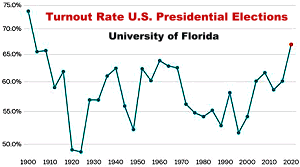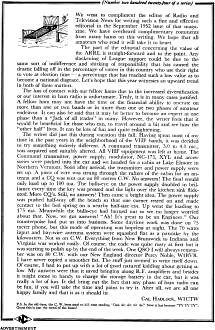|
December 1952 QST
 Table of Contents Table of Contents
Wax nostalgic about and learn from the history of early electronics. See articles
from
QST, published December 1915 - present (visit ARRL
for info). All copyrights hereby acknowledged.
|
 As the opening sentence indicates, National
Company ran a very long series of advertisements in QST magazine that were
in a format more reminiscent of a short essay than a company promotion. This installment
for the December 1952 edition was number 224. Subjects ran the gamut from technical
innovations from the company's research and development laboratory to social and
political issues relevant to electronics technicians, hobbyists, students, and engineers.
Being that it was a
presidential election year in the U.S., National Company felt
compelled to remind readers of their patriotic duty to vote. Although this was the
December issue, it would reach readers' mailboxes prior to the election. Dwight
D. Eisenhower ran against Adlai Stevenson. The latter won the South and the former
won everything else. Note the thinly veiled criticism at the bottom about why amateur
radio participation rate was down at the time. As the opening sentence indicates, National
Company ran a very long series of advertisements in QST magazine that were
in a format more reminiscent of a short essay than a company promotion. This installment
for the December 1952 edition was number 224. Subjects ran the gamut from technical
innovations from the company's research and development laboratory to social and
political issues relevant to electronics technicians, hobbyists, students, and engineers.
Being that it was a
presidential election year in the U.S., National Company felt
compelled to remind readers of their patriotic duty to vote. Although this was the
December issue, it would reach readers' mailboxes prior to the election. Dwight
D. Eisenhower ran against Adlai Stevenson. The latter won the South and the former
won everything else. Note the thinly veiled criticism at the bottom about why amateur
radio participation rate was down at the time.
National Company Advertisement
 Number two hundred twenty-four of a series Number two hundred twenty-four of a series
We wish to compliment the editor of Radio and Television News for writing such
a fine and effective editorial in the September 1952 issue of that magazine. We
have overheard complimentary comments from many hams on this writing. We hope that
all amateurs who read it will take it to heart.
The part of the editorial concerning the value of the ARRL is straight-forward
and to the point. Any slackening of League support could be due to the same sort
of indifference and shirking of responsibility that has caused the drastic falling
off in the percentage of voters in this country who use their right to vote at election
time - a percentage that has reached such a low value as to become a national disgrace.
Let's hope that this year witnesses an upward trend in both of these matters.
 The loss of contact with our fellow hams
due to the increased diversification or our interest in ham radio is unfortunate.
Truly, it is in many cases justified. A fellow ham may not have the time or the
financial ability to operate on more than one or two bands or in more than one or
two phases of amateur endeavor. It can also be said that it may be better to become
an expert at one phase than a "Jack of all trades" in many. However, the writer
feels that it would be beneficial for those who can, to travel around a bit and
see how the "other half" lives. It can be lots of fun and quite enlightening. The loss of contact with our fellow hams
due to the increased diversification or our interest in ham radio is unfortunate.
Truly, it is in many cases justified. A fellow ham may not have the time or the
financial ability to operate on more than one or two bands or in more than one or
two phases of amateur endeavor. It can also be said that it may be better to become
an expert at one phase than a "Jack of all trades" in many. However, the writer
feels that it would be beneficial for those who can, to travel around a bit and
see how the "other half" lives. It can be lots of fun and quite enlightening.
The writer did just this during vacation this fall. Having spent most of my time
in the past years in the neighborhood of the VHF bands, it was decided to try something
entirely different. A command transmitter, 3.0 to 4.0 mc., was acquired and suitably
altered. All VHF equipment was left at home. The Command transmitter, power supply,
modulator, NC-173, XYL and accessories were packed into the car and we headed for
a cabin at Lake Elmore in Northern Vermont. Soon after arrival, the transmitter
and power supply were set up. A piece of wire was strung through the rafters of
the cabin for an antenna and a CQ was sent out on 80 meters C.W. No answers! The
final would only load up to 100 ma. The bulls-eye on the power supply doubled in
brilliance every time the key was pressed and the light over the kitchen sink flickered.
More CQ's. Still, no answers! Then came a bright idea. The power supply was pushed
half-way off the bench so that one corner rested on and made contact to the bed
spring on a nearby half-size cot. Up went the loading to 175 ma. Meanwhile the bulls-eye
had burned out so we no longer worried about that. Now, we got answers! "Ah! It's
great to be an Engineer." Our counterpoise had put us into business. Some daytime
work was done on 75 meter phone, but this mode of operating was hopeless at night.
The 70 watts input and hay-wire antenna system were squashed flat as a pancake by
the kilowatters. Not so on C.W. Everything from New Brunswick to Indiana and Virginia
was worked easily. Of course, the code was quite rusty at first but it was starting
to polish up by the end of the week. One QSO I will always remember was on 80 C.W.
with our New England director Percy Noble, W1BVR. I have never copied a smoother
fist. The stuff just seemed to write itself down. Of course, I had to put up with
a lot of good natured kidding about getting so low. My answers were that it saved
bringing along R.F. amplifiers and besides it might come in handy to charge the
storage battery in the car, but it was really a lot of fun. It did bring out the
fact that any phase of ham radio can be fun, if you will take the time and pains
to try it. After all, we are all one happy family and that is as it should be.
Cal Hadlock, W1CTW
P.S. In the old days, the C. W. boys used to kill time sending "Dah dit dit dit
da," Now it has become "TV TV TV". Guess this is just the trend of the times!
Posted June 24, 2022
(updated from original post on
6/28/2016)
Here are all the National Company advertisements I have:
- National's Company:
Merry Christmas and Happy New Year, January 1941
- National Company:
Noise Limiters, September 1950
- National Company: Modulators, April
1942
- National Company: Switches,
May 1939
- National Company: TMS Condenser, March 1939
- National Company: TVI, October
1953
- National Company:
Amateur Radio Activity, December 1952
- National Company: HRO-50
Receiver, May 1951
- National Company:
Noise Limiters, September 1950
- National
Company: Modulation, October 1947
- National Company:
Merry Christmas and Happy New Year, January 1942
- National Company:
Merry Christmas and Happy New Year, January 1941
- National Company: Switches,
May 1939
- National Company: AC Power Strip,
April 1939
- National Company: TMS Condenser,
March 1939
- National Company Catalog: NC80X
/ NC81X Receiver Advertisement, September 1937
- National Company:
IF Circuits, September 1935
|










 Number two hundred twenty-four of a series
Number two hundred twenty-four of a series

